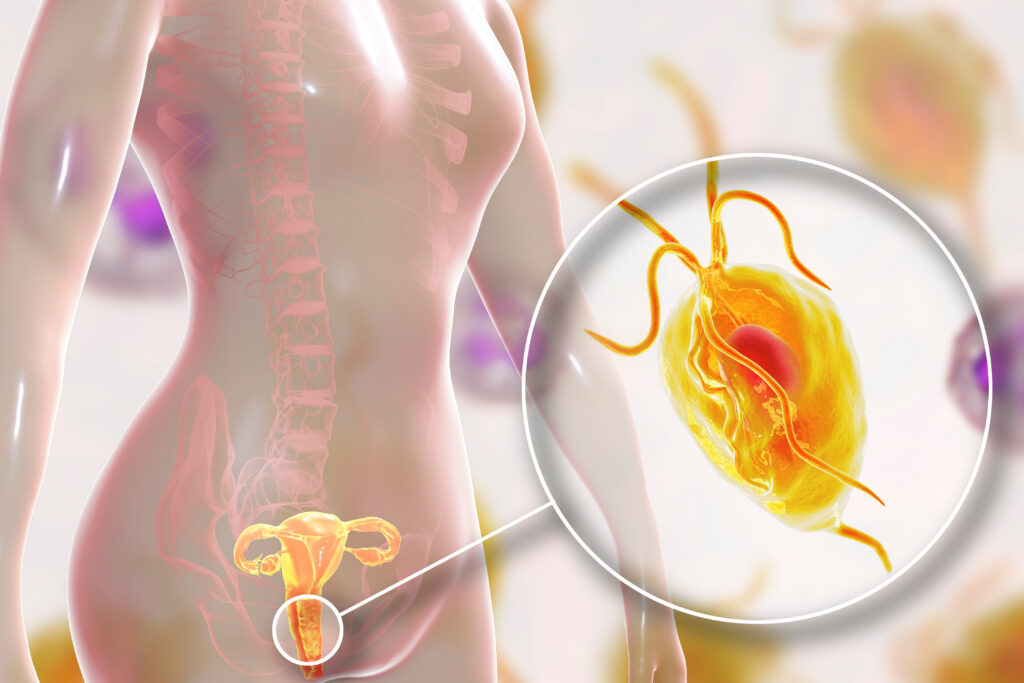Unusual bleeding can be a sign of certain STDs. This article explains which STDs can cause bleeding, their symptoms, and the steps you need to take for prevention and treatment.
Key Takeaways
- Unusual vaginal bleeding can indicate STDs like chlamydia and gonorrhea, making early medical consultation crucial to avoid severe health issues.
- Chlamydia and gonorrhea can cause irregular bleeding and significant reproductive complications if left untreated; regular screenings are important for early detection.
- Prevention strategies for STDs include using condoms, reducing sexual partners, and regular testing, particularly among young individuals aged 15 to 24.
STDs and Unusual Vaginal Bleeding
Unusual vaginal bleeding can signal underlying issues, including sexually transmitted infections (STIs) like chlamydia and gonorrhea. Experiencing irregular bleeding or spotting between periods can be unsettling, so recognizing these signs and seeking timely medical advice is crucial.
Pelvic pain and unexplained bleeding can indicate an STI and should never be ignored. If not addressed, they can lead to more severe health problems. Visiting a sexual health clinic at the first sign of unusual vaginal bleeding helps ensure women’s health.
Frequent or unusual vaginal bleeding may also signal severe conditions like pelvic inflammatory disease or cervical cancer. Consulting healthcare professionals to determine the cause and receive appropriate treatment is crucial.
Chlamydia and Irregular Vaginal Bleeding
According to the Centers for Disease Control, Chlamydia often causes no symptoms until significant damage has occurred. Irregular vaginal bleeding, which can happen between menstrual cycles or after sexual intercourse, is a notable symptom. This bleeding results from inflammation of the cervix or uterus, disrupting the regular menstrual cycle.
In addition to irregular bleeding, chlamydia can cause other symptoms such as a pus-like yellow discharge, pain or burning during urination, and lower abdominal pain. If left untreated, it can lead to more severe conditions like pelvic inflammatory disease (PID) and is responsible for about 90% of PID cases.
Early recognition and treatment of chlamydia symptoms prevent long-term damage to the fallopian tubes and other reproductive organs. Regular screenings, especially for sexually active individuals, are key for early detection and treatment.
Gonorrhea Symptoms: Spotting and Heavy Bleeding
Gonorrhea can significantly disrupt the menstrual cycle. Symptoms often include bleeding between periods or after sexual activity, which can be distressing. The infection spreads to the uterus or cervix, causing inflammation and increased mucus production, leading to spotting and heavier bleeding.
Spotting is an early symptom of gonorrhea. If left untreated, it can result in more severe bleeding and other complications, interfering with daily life and indicating that the infection is affecting the reproductive organs.
Timely treatment of gonorrhea prevents long-term health issues. Regular visits to a sexual health clinic for testing and treatment help manage symptoms and prevent complications.
Trichomoniasis and Genital Tract Inflammation
Trichomoniasis, a lesser-known but impactful parasitic STD, causes genital tract inflammation and bleeding. This parasite-induced infection leads to noticeable genital irritation and discomfort, significantly affecting sexual health. The inflammation can result in spotting and heavier menstrual bleeding.
A pelvic exam may reveal a “strawberry cervix,” a tell-tale sign of trichomoniasis. This condition is more symptomatic in women, who are more likely to experience the associated discomforts compared to men.
Recognizing trichomoniasis symptoms and seeking prompt treatment can alleviate discomfort and prevent the spread of the infection. Regular screenings and maintaining good sexual health practices are essential for managing and preventing this STD.
Genital Herpes and Bleeding Sores
Genital herpes, caused by the herpes simplex virus, leads to painful blisters that can rupture and bleed. These sores, along with a burning sensation and painful urination, are characteristic symptoms. Early recognition is crucial for seeking appropriate medical care.
The lesions caused by genital herpes can be particularly distressing due to the pain and bleeding they cause. Managing these symptoms with a healthcare provider’s help can significantly improve quality of life.
Understanding genital herpes and its symptoms is vital. Early medical intervention can help manage outbreaks and reduce their severity, highlighting the importance of timely medical advice.
Pelvic Inflammatory Disease (PID) and Severe Cases of Bleeding
Pelvic inflammatory disease (PID) is a severe complication from untreated STDs like chlamydia and gonorrhea. This condition can lead to severe bleeding and other significant health issues, including infertility. The inflammation from these infections can progress to PID, increasing the risk of more severe bleeding.
Symptoms of PID include abdominal pain, lower abdominal pain, and urination pain, often accompanied by unusual vaginal bleeding. Severe cases may require hospitalization and intravenous antibiotics to manage the infection and prevent further complications.
Recognizing the signs of PID and seeking immediate medical attention is crucial. Early treatment can prevent long-term health issues and improve outcomes for those affected.
Diagnosing STDs That Cause Bleeding
Diagnosing STDs that can cause bleeding is crucial for effective treatment and management. Many infections, like chlamydia, are often asymptomatic, making regular screenings vital for early detection. Confirming an STD diagnosis through testing is particularly important for those experiencing unusual bleeding.
Healthcare providers use methods like urine or swab tests to screen for common STDs, ensuring early diagnosis and treatment. Regular testing is recommended for sexually active individuals, especially those with new or multiple partners.
Medical evaluation and regular STD testing help manage symptoms effectively and prevent the spread of infection. Early diagnosis is key to maintaining sexual health and well-being.
Treatment Options for STD-Related Bleeding
Treating STDs involves tailored options for specific infections. Early intervention mitigates complications and supports recovery. Antibiotics effectively treat many STDs and reduce related bleeding, while antivirals manage symptoms and reduce outbreaks for viral infections.
Education on STDs empowers individuals to recognize symptoms early, leading to timely treatment and preventing complications. Expedited partner therapy allows healthcare providers to treat partners of infected individuals without prior examination, helping to prevent reinfection.
Regular follow-up appointments monitor treatment effectiveness and ensure the infection is fully resolved. Adhering to treatment plans can significantly improve outcomes for those affected by STD-related bleeding.
Prevention Tips for Sexual Health
Preventing STDs is critical for maintaining sexual health and avoiding complications like unusual vaginal bleeding.
While abstinence is the only way to fully avoid sexually transmitted infections, practical steps like:
- Using condoms correctly during sexual intercourse
- Getting regularly tested for STDs
- Limiting the number of sexual partners
- Having open discussions with partners about sexual health can reduce risk.
Limiting the number of sexual partners and being in a mutually monogamous relationship with a tested partner are effective strategies for reducing STI risk. Regular screenings for STDs are crucial since many infections can be present without symptoms.
Education on STIs is crucial, especially for young people aged 15 to 24, who account for about half of new infections. Understanding prevention methods and maintaining open communication with partners can significantly lower STD risk and promote sexual health.
Educating Yourself About STDs
Education is a powerful tool in the fight against STDs. Recognizing symptoms and seeking timely medical advice can prevent complications and improve outcomes. For instance, symptoms from the first outbreak of genital herpes tend to be more severe compared to subsequent occurrences.
Knowing that genital herpes sores may take up to four weeks to heal during the initial outbreak can prepare individuals for recovery. Subsequent episodes usually last between one and two weeks, making recognizing and managing symptoms essential.
Regular STD testing and awareness help sexually active individuals maintain their health and prevent the spread of infections. Educating oneself about common sexually transmitted diseases like chlamydia and gonorrhea is crucial for making informed decisions about sexual health.
Summary
Understanding the link between STDs and unusual vaginal bleeding is crucial for timely intervention and maintaining reproductive health. Recognizing symptoms, seeking medical advice, and adhering to treatment plans can prevent long-term complications and improve quality of life. Prevention through safe sex practices and regular screenings is essential for managing and reducing the risk of STDs.
Empowering yourself with knowledge and taking proactive steps towards sexual health can make a significant difference. Stay informed, practice safe sex, and prioritize regular medical check-ups to ensure your well-being.
FAQs
What are the common STDs that cause unusual vaginal bleeding?
Unusual vaginal bleeding can commonly be caused by sexually transmitted diseases such as chlamydia, gonorrhea, trichomoniasis, and genital herpes. It’s important to seek medical advice if you experience such symptoms.
How can I prevent STDs that cause bleeding?
To effectively prevent sexually transmitted infections that can cause bleeding, consistently use condoms, limit sexual partners, undergo regular screenings, and maintain a mutually monogamous relationship with a tested partner. These practices significantly reduce your risk.
What are the symptoms of chlamydia that can lead to bleeding?
Chlamydia can cause irregular vaginal bleeding, which is a significant symptom to be aware of, along with yellow discharge and lower abdominal pain. If you experience these symptoms, it is important to seek medical attention promptly.
Why is regular STD testing important?
Regular STD testing is crucial as many infections do not show symptoms, allowing for early detection that helps manage health and prevents complications. Prioritizing these tests is essential for maintaining overall well-being.
What treatments are available for STDs that cause bleeding?
Effective treatments for STDs that cause bleeding include antibiotics for bacterial infections and antivirals for viral infections, with regular follow-ups to monitor their effectiveness. If you’re experiencing symptoms, seeking medical advice promptly is essential.
Sources
Sexually transmitted disease (STD) symptoms: https://www.mayoclinic.org/diseases-conditions/sexually-transmitted-diseases-stds/in-depth/std-symptoms/art-20047081
What are Sexually Transmitted Infections (STIs) or Diseases (STDs)?: https://www.urologyhealth.org/urology-a-z/s/sexually-transmitted-infections
Sexually transmitted infections (STIs): https://www.nhs.uk/conditions/sexually-transmitted-infections-stis/







